#digital grain moisture meter
Text

Digital Grain Moisture Meter is a cutting-edge digital instrument that measures the moisture content of a wide range of agricultural grains automatically. It offers the most sophisticated revision method as well as an easy-to-use material type selection option. This device's main features include automatic temperature adjustment and moisture correction in the event that no material is measured. It has an automated power shut-off feature and runs on AA batteries. It works best for measuring the moisture content of agricultural grains such as rice, wheat, soybeans, coffee beans, and silt for more visit labtron.us.
0 notes
Text
Portable Grain Moisture meter
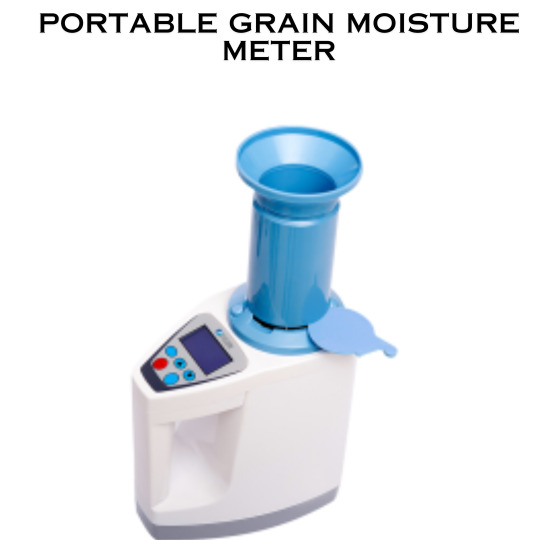
A portable grain moisture meter is a handheld device used to measure the moisture content of grains and seeds. It's an essential tool for farmers, grain handlers, and food processors to ensure the quality and storage stability of their grain products. Automatic sample weighing.
0 notes
Text
Popular digital grain moisture content meters
How Does Moisture Content Affect Coffee Roasters?
At each stage of the coffee supply chain, the moisture content of a green bean must diminish – or the bean might become moldy, defective, and less valuable than before. Ensuring a bean dries correctly is essential in order to optimize its quality potential and minimize the chance of problems.Roasters, near the end of the supply chain, have two…

View On WordPress
#Animal scales#assorted weighing brands including Avery#Axle weigh bridge#Baby scales#Bag closers-stitching machine#Barcode readers/printer#Batch sealers#Counter scales#Crane (hanging) scales#Health ( height and weight ) scales#Industrial platforms#kitchen scales#Mini palm scales#Moisture meters#Pallet trolleys#Plastic bag sealers#Plastic foot sealers#Precision scales Analytical/Laboratory scales#Salter#Table top scales#Temperature gauges#Waterproof scales#Whole sale scales
2 notes
·
View notes
Text
Grain Moisture Meter
Grain Moisture Meter NGMM-100 is a portable device with an integrative design and a measuring range of 6%-30%. Designed for fast and accurate measurement of moisture in the process of allotment, acquisition, storage, machining of packed grains. Equipped with digital display and back light gives precise readings. Reliable, robust grain meter built to meet the requirements of grain handling operations.

0 notes
Text
Enhancing Agricultural Efficiency: The Importance of Digital Moisture Meters
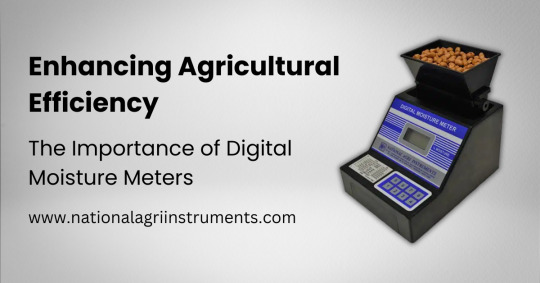
In the realm of Modern Agriculture, precision and efficiency are paramount for ensuring optimal crop yield and quality. One indispensable tool that plays a crucial role in achieving these goals is the Digital Moisture Meter. With its advanced features and capabilities, the digital moisture meter revolutionizes the way farmers and agricultural professionals monitor and manage moisture levels in soil, grains, and other agricultural products.
Automatic Inbuilt Temperature Compensation
Traditional moisture measurement methods often fall short in accurately accounting for temperature variations, which can significantly affect moisture readings. However, Digital Moisture Meters come equipped with automatic inbuilt temperature compensation features. This ensures that moisture readings remain precise and reliable regardless of fluctuating environmental conditions, empowering farmers to make informed decisions about irrigation and crop management.
"LOBAT" / "BAT" Indication
The last thing farmers need is a disruption in their operations due to weak battery power. Digital moisture meters address this concern by incorporating "LOBAT" / "BAT" indication features. This alerts users when the battery is running low, allowing for timely replacement and uninterrupted usage. As a result, farmers can rely on continuous and accurate moisture measurements without any downtime or inaccuracies caused by insufficient battery power.
ABS Moulded Body
Agriculture is inherently demanding, often subjecting equipment to rugged conditions in the field. Recognizing this challenge, digital moisture meters are designed with ABS molded bodies that offer exceptional durability and longevity. This robust construction ensures that the moisture meter can withstand the rigors of field use, providing farmers with a reliable tool that stands the test of time.
No Mechanical Moving Parts
Unlike traditional moisture meters that rely on mechanical components, digital moisture meters are engineered without any moving parts. This design eliminates the risk of wear and tear, minimizing maintenance requirements and ensuring consistent performance over an extended duration. Farmers can enjoy hassle-free operation and peace of mind, knowing that their digital moisture meter will deliver accurate results without the need for frequent repairs or replacements.
Non-destructive Sample Testing
Preserving the integrity of agricultural samples is crucial for maintaining product quality and minimizing waste. Digital moisture meters offer non-destructive sample testing capabilities, allowing farmers to assess moisture levels without altering or damaging the samples. This not only streamlines the testing process but also ensures that valuable agricultural products remain intact and usable throughout the measurement process.
Conclusion
In conclusion, the digital moisture meter stands as a transformative tool in modern agriculture, offering unmatched accuracy, efficiency, and reliability in moisture measurement. By harnessing the power of this innovative technology, farmers can optimize their irrigation practices, improve crop yield and quality, and ultimately, drive sustainable agricultural productivity.
As a leading manufacturer of digital moisture meters in India, National Agri Instruments is committed to empowering farmers with cutting-edge solutions that address their evolving needs. Our state-of-the-art moisture meters, equipped with features such as automatic inbuilt temperature compensation, robust ABS molded bodies, and non-destructive sample testing capabilities, are designed to streamline moisture measurement processes and enhance agricultural outcomes.
By Choosing National Agri Instruments, Farmers gain access to not only premium-quality digital moisture meters but also expert support and guidance every step of the way. Our dedicated team is committed to providing personalized assistance, training, and ongoing maintenance services to ensure that farmers derive maximum value from their investment.
In partnership with National Agri Instruments, farmers can embark on a journey towards greater efficiency, productivity, and sustainability in agriculture. Together, we can harness the potential of digital moisture meters to transform the way we cultivate and nourish the world.
#Digital Moisture Meter#Digital Moisture Meter Manufacturer#Farming Technology#Precision Agriculture#Soil Health#Crop Management
0 notes
Text
Popular digital grain moisture content meters
At each stage of the coffee supply chain, the moisture content of a green bean must diminish – or the bean might become moldy, defective, and less valuable than before. Ensuring a bean dries correctly is essential in order to optimize its quality potential and minimize the chance of problems.
Roasters, near the end of the supply chain, have two tasks when it comes to managing moisture content. On the one hand, they must maintain the lots they store onsite within a narrow moisture range that is acceptable to their quality standards. They need to hold their coffee in this range for a period that will, hopefully, not be longer than a year.

0 notes
Text
Digital moisture tester for over 25 grain species
How Does Moisture Content Affect Coffee Roasters?
At each stage of the coffee supply chain, the moisture content of a green bean must diminish – or the bean might become moldy, defective, and less valuable than before. Ensuring a bean dries correctly is essential in order to optimize its quality potential and minimize the chance of problems.
Roasters, near the end of the supply chain, have two tasks when it comes to managing moisture content. On the one hand, they must maintain the lots they store onsite within a narrow moisture range that is acceptable to their quality standards. They need to hold their coffee in this range for a period that will, hopefully, not be longer than a year.
On the other hand, and in the span of a few minutes, the roaster is responsible for driving the last remaining bits of moisture out of the bean via the application of intense heat and pressure. In these minutes, the coffee is exposed to the most energy it will experience at any point in the coffee supply chain and the roast is set up for either success or failure.
It’s easy to see why roasters should care about the moisture content of their coffee. But how useful is a number supplied by an importer, and how can roasters integrate moisture content readings into their craft? I spoke with Fred Seeber of Shore Measuring Systems, a supplier of moisture content meters, about measuring and making sense of moisture content in green coffee.
What Is The “Ideal” Moisture Content?
There is no official standard for ideal moisture content in green coffee, although the ICO recommends 11% as a good target. However, it’s commonly accepted that 10-12% is a reasonable range. Anything less than 10% is likely to result in loss of cup quality, while humidity at higher levels begins to create a risk of mold growth.
Yet a coffee’s humidity is not static. While the pre-export drying process drastically increases a bean’s stability, changes in moisture content are still possible. Environmental factors, such as being in a particularly humid or hot location, are a common cause of this.
Measuring Moisture Content: Is It Really Necessary?
Before getting into the technical details of measuring moisture content, it’s worth digging a little deeper into why it’s worth measuring moisture content. Knowing this will help you establish protocols suited to your specific needs.
For roasters of a certain scale, it’s simple: you pay for coffee by weight; the more water in that coffee, the more you’ve paid for water which you’re going to burn off anyway.
Fred describes a common situation roasters find themselves in: “So, [an importer] sends you a sample, and… it’s showing 11.5% moisture in that sample. Then when your container shows up, that’s 40,000 pounds, and all of the sudden you discover it could be 13% moisture. Well, you just got blanked for two percentage points of water of a commodity that’s four bucks a pound… that’s [a lot] of money.”
For the smaller, quality-focused roaster, those kinds of calculations may or may not be relevant. But moisture content still plays an indirect role in a roaster’s costs, regardless of whether or not they’re buying a few containers or a few bags.
There is no direct link between a coffee’s quality and its moisture content. A 10% humidity coffee is not necessarily better or worse than a 12% coffee. However, over time, green coffee will gradually lose vibrance. This will eventually result in the dreaded “past crop” flavor, and this process is associated with the drying out of the coffee.
Therefore, even for a small roaster, it’s important to keep track of moisture content. If you paid for an 85-point coffee at 12% moisture, by the time it reaches 10% moisture it may be more like an 83-point coffee. Yet, you still paid 85-point prices for it originally.
By comparing moisture content loss with quality degradation over time, you can make smart buying and consumption decisions with your green lots. And, when combined with water activity measurements, you can even predict the shelf life of your green coffee. Again, precision here is key: you want to track your coffee through a narrow range of percentage points over a long time frame.
Lastly, you may think to yourself that you don’t need to measure moisture content yourself, since your importer supplies those numbers already. Fred cautions against this thinking. He points out that coffee is shipped on water and that ports can often be warm and humid, which will affect moisture readings.
So, if you’re a roaster in a dry part of the United States but your importer is located in New Orleans or Houston, and is taking moisture readings from lots right as they arrive, those numbers might not be applicable to you by the time your coffee arrives at your facility.
Thank you for allowing Accurate Weighing Scales (U) Ltd the privilege to serve you in advance.
For inquiries on deliveries contact us
Office +256 705 577 823, +256 775 259 917
Address: Wandegeya KCCA Market South Wing, 2nd Floor Room SSF 036
Email: [email protected]
https://weighingscalesineastafrica.wordpress.com/category/analytical-balance/
https://weighingscalesineastafrica.wordpress.com/category/medical-use-weighing-scales/
https://weighingaccurate.wordpress.com/category/medical-weighing-scales/
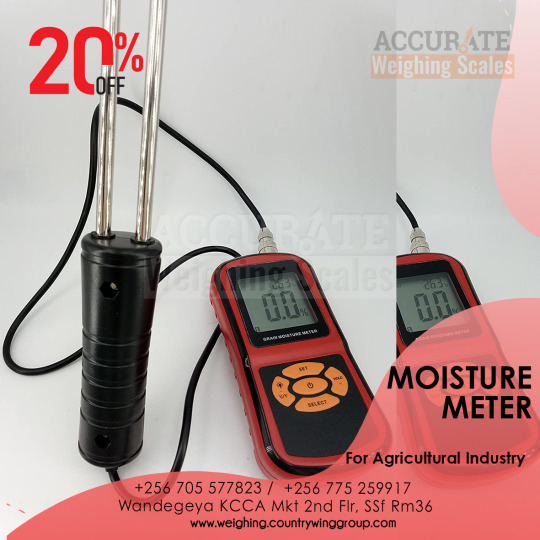
0 notes
Text
Popular digital grain moisture content meters
How to Choose the Right Grain Moisture Meter for Your Needs
If you work with grains in any capacity, whether as a farmer, a commodity trader, aggregator, or feed producer, then a grain moisture meter is a piece of equipment you absolutely need. In this article, you’ll learn about grain moisture meters, why you need one, how they work and how to choose the best moisture meter for your operations.
Why you need a grain moisture meter
Grain moisture meters are tools that help you measure the moisture content in different grains, before, during, and after harvest. Measuring the moisture content of your grains helps you know whether your grains are dry enough. Knowing the moisture content of your grains is important because the high moisture content in grains leads to mold growth and aflatoxin contamination which destroy grains.
For farmers, the high moisture content in grains could cause you to lose a big chunk of your harvest – which in itself is a scary thought. Also for commodity traders, many buyers require you to meet certain moisture content standards before they will accept your grain.
In addition, many buyers want the moisture content of corn to remain below 13% otherwise they will not buy. Finally, for poultry farmers and feed producers, the high moisture content in grains can affect the quality of your feed and ultimately the productivity of your birds.
While there are ingenious ways to estimate the moisture content in grains, the best way is to use a grain moisture meter. As it offers precise and accurate measurements, letting you know whether your grains are dry enough or if they should be dried some more. Ingenious ways like biting the kernel or tossing a handful of grains to listen for the sound they make do not offer such benefits.
Types of grain moisture meters and how they work
There are different kinds of moisture meters, each with its own principle of operation and underlying technologies.
Probe-type moisture meters like the GrainMate Grain Moisture Meter use a sensor to measure the temperature and humidity of the grains. It also comes along with special mathematical models to tell the equilibrium moisture content (EMC) in a grain sample.
Sesi Technologies GrainMate Grain Moisture Meter
Cup-type meters like the John Deere Moisture Check Plus SW08120 use a high frequency capacitive circuit to measure the moisture content in a small gain sample.
John Deere Moisture Check Plus SW0812
Other types of moisture meters like the AgraTronix 08201, GMT-Grind Portable Grain Moisture Meter use a grinder to grind a small sample of the grain in order to measure the in the sample.
AgraTronix 08201, GMT-Grind Portable Grain Moisture Meter
Choosing the right moisture meter for your operations
There are a lot of factors to consider when choosing a grain moisture meter. These include accuracy, ease of use, price, mode of operation, calibration, moisture measurement range, number of species supported, and more. If you frequently test the moisture content on the field before harvest, then a grinder-type meter or a cup-type meter will be most suitable for you. As it can tell you if your grains are dry enough for harvest.
Many of these moisture meters support several species, have a wide measurement range, and can be calibrated.
In Africa where grains are usually packed and stored in 50kg to 130kg sacks, a probe-type grain moisture meter like the GrainMate GM-102 is a very suitable choice for African farmers and aggregators. This is because it can be used to easily probe bags and take moisture readings within a short time both during and after harvest.
The GrainMate Moisture Meter comes with a mobile app that lets users record, track the moisture content of grains across different suppliers and get useful recommendations. Aside from being effective and accurate, GrainMate Moisture Meter is considerably less expensive than other meters on the market. And affordability is very important since most farmers in Africa are unable to afford expensive technology tools. The GrainMate Moisture Meter is also very portable, easy to use, and can be calibrated. It also supports popular grains grown in Africa including corn, rice, wheat, sorghum, soybeans, millet, and groundnuts.
Closing thoughts
It’s a proven fact that poor moisture content in grains can have adverse effects on the quality of grains. This could result in big losses for both farmers and traders. Which is why you need to have a good quality moisture meter to measure the moisture content in your grains before, during and after harvest.
The right grain moisture meter is a good investment that will definitely help you reduce losses and save money for several years. For farmers in Africa, the GrainMate Moisture Meter is an excellent moisture meter developed and manufactured in Africa. Learn more about GrainMate Moisture Meter and see how our meter can benefit your operations today.
Share this post
Stop Losing Money!
Are you a grain farmer, grain trader or agribusiness? Discover how our technologies can help you reduce post-harvest losses, maximize your productivity and increase your income.
Thank you for allowing Accurate Weighing Scales (U) Ltd the privilege to serve you in advance.
For inquiries on deliveries contact us
Office +256 705 577 823, +256 775 259 917
Address: Wandegeya KCCA Market South Wing, 2nd Floor Room SSF 036
Email: [email protected]
https://barcodescalesuganda.wordpress.com/category/chair-weighing-scales/
https://weighingscalesineastafrica.wordpress.com/category/analytical-balance/
https://weighingscalesineastafrica.wordpress.com/category/medical-use-weighing-scales/
https://weighingaccurate.wordpress.com/category/medical-weighing-scales/
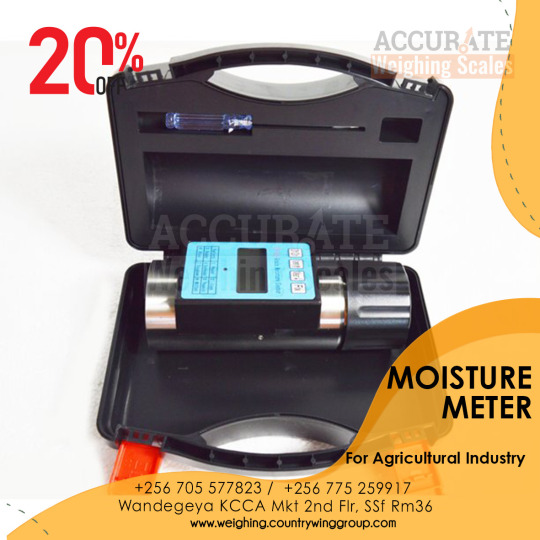
0 notes
Text
Popular digital grain moisture content meters
There is no official standard for ideal moisture content in green coffee, although the ICO recommends 11% as a good target. However, it’s commonly accepted that 10-12% is a reasonable range. Anything less than 10% is likely to result in loss of cup quality, while humidity at higher levels begins to create a risk of mold growth.
Yet a coffee’s humidity is not static. While the pre-export drying process drastically increases a bean’s stability, changes in moisture content are still possible. Environmental factors, such as being in a particularly humid or hot location, are a common cause of this.
Measuring Moisture Content: Is It Really Necessary?
Before getting into the technical details of measuring moisture content, it’s worth digging a little deeper into why it’s worth measuring moisture content. Knowing this will help you establish protocols suited to your specific needs.
For roasters of a certain scale, it’s simple: you pay for coffee by weight; the more water in that coffee, the more you’ve paid for water which you’re going to burn off anyway.
Fred describes a common situation roasters find themselves in: “So, [an importer] sends you a sample, and… it’s showing 11.5% moisture in that sample. Then when your container shows up, that’s 40,000 pounds, and all of the sudden you discover it could be 13% moisture. Well, you just got blanked for two percentage points of water of a commodity that’s four bucks a pound… that’s [a lot] of money.”
For the smaller, quality-focused roaster, those kinds of calculations may or may not be relevant. But moisture content still plays an indirect role in a roaster’s costs, regardless of whether or not they’re buying a few containers or a few bags.
There is no direct link between a coffee’s quality and its moisture content. A 10% humidity coffee is not necessarily better or worse than a 12% coffee. However, over time, green coffee will gradually lose vibrance. This will eventually result in the dreaded “past crop” flavor, and this process is associated with the drying out of the coffee.
Thank you for allowing Accurate Weighing Scales (U) Ltd the privilege to serve you in advance.
For inquiries on deliveries contact us
Office +256 705 577 823, +256 775 259 917
Address: Wandegeya KCCA Market South Wing, 2nd Floor Room SSF 036
Email: [email protected]
https://pallettrolleys.wordpress.com/category/crane-weighing-scales/
https://weighingaccurate.wordpress.com/category/crane-weighing-scales/
https://weighingscalesineastafrica.wordpress.com/category/crane-weighing-scales/
https://weighingscalesineastafrica.wordpress.com/category/portable-and-luggage-weighing-scales/
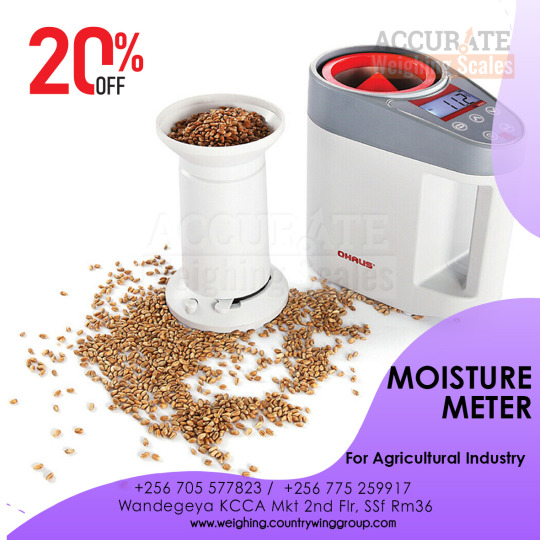
0 notes
Photo
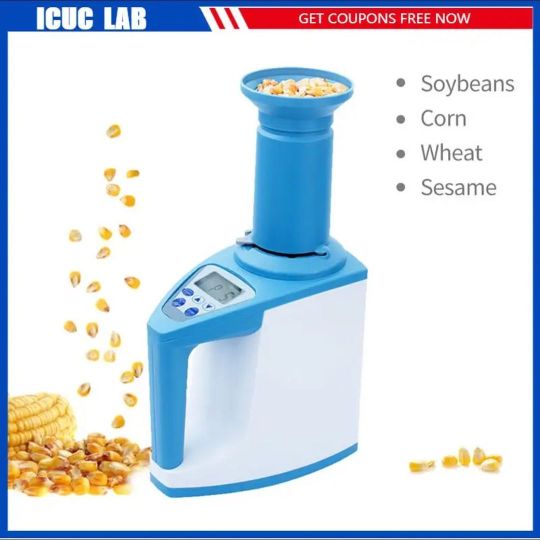
LDS-1G Grain Moisture Meter High Precision Automatic Digital Peanut Corn Rice Wheat Moisture Humidity Gauge Tester Detector https://a.aliexpress.com/_mL7sYeU https://www.instagram.com/p/CrVKo33J5yq/?igshid=NGJjMDIxMWI=
0 notes
Text
Grain Moisture Meter
Grain Moisture Meter NGMM-100 is a portable device with an integrative design and a measuring range of 6%-30%. Designed for fast and accurate measurement of moisture in the process of allotment, acquisition, storage, machining of packed grains. Equipped with digital display and back light gives precise readings. Reliable, robust grain meter built to meet the requirements of grain handling operations.

0 notes
Text
Agratronix MT-Pro Portable Moisture Tester
Agratronix MT-PRO Portable Grain Moisture Tester Part No. 08125 Features Direct readout for 40 different grain scales Backlit display for nighttime use Built-in calibration button for displaying the average of saved test results Multi-language display - English, Spanish, French, German, Italian, Portuguese and Swedish.
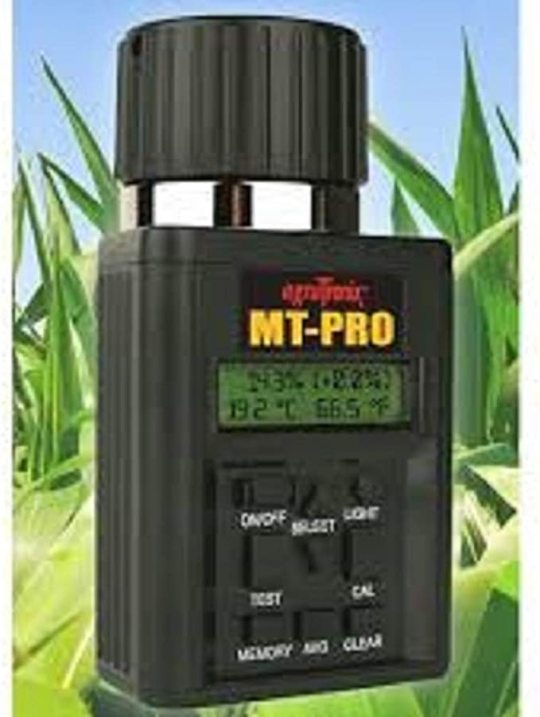
0 notes
Text
analytical balance with rechargeable battery at affordable prices in store Kampala
Analytical balances and laboratory scales are both weighing instruments used in laboratory settings, but there are some key differences between the two. Here's an overview of analytical balances and laboratory scales:
Laboratory Scales Weighing Instruments in Kampala Uganda
Laboratory scales are more general-purpose weighing instruments used in a wide range of laboratory applications. While they are not as sensitive or precise as analytical balances, they still provide accurate measurements for many laboratory needs. Key features of laboratory scales include:
Lower precision: Laboratory scales typically offer precision to the nearest gram or higher, depending on the model and application.
Open design: Unlike analytical balances, laboratory scales usually do not have an enclosed weighing chamber.
Calibration: Like analytical balances, laboratory scales require periodic calibration to maintain accuracy.
Various weighing capacities: Laboratory scales come in a range of capacities, from a few grams to several kilograms, to accommodate different weighing needs.
Digital or analog display: Laboratory scales may have either a digital or analog display, depending on the model.
Versatility: Laboratory scales are suitable for a wide range of applications, including sample preparation, general weighing tasks, formulation, and inventory management.
Analytical Balances Highly Precise Instruments in Kampala
Analytical balances are highly precise instruments designed for accurate measurement of mass or weight. They are commonly used in scientific research, pharmaceutical laboratories, and quality control applications where precise measurements are essential. Key features of analytical balances include:
High precision and sensitivity: Analytical balances can measure weights with a high level of sensitivity, often to the nearest decimal place (e.g., 0.0001 grams).
Enclosed weighing chamber: Analytical balances typically have an enclosed chamber with glass or acrylic doors to protect the weighing pan and sample from air currents and external influences.
Anti-vibration features: They are equipped with anti-vibration systems to minimize the impact of external vibrations on measurement accuracy.
Calibration: Analytical balances require regular calibration using calibrated weights to maintain accuracy.
Draft shield: Many analytical balances have a draft shield, which is a transparent enclosure around the weighing chamber, to protect the sample from air currents and minimize static electricity effects.
Digital display: Analytical balances feature a digital display that shows precise measurements, often with additional features such as tare, unit conversion, and data connectivity options.
In summary, analytical balances are designed for high precision and sensitivity, ideal for precise analytical measurements, while laboratory scales offer a broader weighing range and are suitable for general laboratory weighing tasks. The choice between the two depends on the specific requirements of the laboratory and the level of precision needed for the intended application.
Thank you for allowing Accurate Weighing Scales (U) Ltd the privilege to serve you in advance.
For inquiries on deliveries contact us
Office +256 705 577 823, +256 775 259 917
Address: Wandegeya KCCA Market South Wing, 2nd Floor Room SSF 036
Email: [email protected]

0 notes
Text
Draminski Portable Grain Moisture Meter
Draminski Portable Grain Moisture Meter

Product Review
you will know the quality of your grain
you will be able to control moisture of your grain before selling it
you will save time and money connected with deductions when selling your grain
you will be able to store your grain safely for a long time
you will decrease risk of heating the grain in silos and appearance of mould
৳ 23,500.00Draminski Portable Grain Moisture Meter Details
View On WordPress
#digital grain moisture meter#digital moisture meter#digital moisture meter music#draminski#draminski grain moisture meter#grain#grain meter#grain moistre and weight meter#grain moisture#grain moisture meter#Grain Moisture Meter Bangladesh#grain moisture meter calibration#grain moisture meter manufacturers#grain moisture meter online#grain moisture tester#maize moisture meter#meter#Moisture#Moisture Meter#moisture meter (measuring instrument)#moisture tester#paddy moisture meter#rice moisture meter#seed#shimana grain moisture meter#tester
0 notes
Video
youtube
Moisture Meter, Seed Grain Testing Lab Equipment, Fruit Sizer - Green Agritech Equipment in Haryana
We are a well reputed company, consistently engaged in designing and manufacturing wide range of testing equipment. Quality for us is the prime objective, and we always focus on offering flawless products at competitive rate. We are known as one of the noted manufacturers, exporters, traders and suppliers of the domain. Established in 2007, we are engaged in manufacturing superior quality testing devices. The offered range comprises Grain Moisture Meter, Sample Divider, Rice Polisher, Rice Miller, Paddy De-husker, Seed Analysis Kit, Seed Germinator, and more. These are appreciated for their high performance, durability and accurate results.Factory Manufacturing:-• Machinery - 6 Machinery• Production Capacity - 300Moisture meter in one month.• Raw Material Used - MS Sheet, rod, brass sheet,rod stainless steel sheet, rod, wire, switch, light, wooden plate, etc.Clients • Agriculture college• Agriculture research center• food corporation of india• center warehouse• state warehouse• rice mill• corporate department mandi • Prisad.• PatanjaliPackaging Material• Wooden crate• wooden box• thermocol sheet• cardbod boxesCustomized Packaging Facility - Strip Packing Machine
Deals In: Moisture Meter, Advance Digital Moisture Meter, Advance Handy Digital Moisture Meter, Chlorophyll Meter, Digital Grain Moisture Meter, Digital Moisture Meter, Halogen Moisture Meter, Handy Digital Moisture Meter, Portable Grain Moisture Meter, Universal Digital Moisture Meter, Seed Grain Testing Lab Equipment, Grain Testing Dryer, Lab Willy Grinder, Riffle Grain Divider, Seed Counter, Seed Dryer, Seed Germinator Double Chamber, Seed Germinator Single Chamber, Soil Moisture Meter, Rice And Grain Testing Lab Equipments, Broken Rice Separator, Grain Analyser, Grain Sample Divider, Grain Size Vernier Calliper, Mini Lab Husker, Paddy Cleaner Seed Grader, Palm Husker, Rice Aspirator, Rice Emasculator, Rice Polisher, White Enamel Plate, Fruit Testing Equipment, Digital Fruit Penetrometer, Fruit Penetrometer, Fruit Sizer
Contact Detail: Contact Person: Mr. Vijay VermaAddress: 34 Hari Nagar Behind B.D Flour Mill., Ambala Cantt, Haryana, India, 133001.Mobile No: +91-9896118188 / 7056788567Email ID: [email protected]: https://www.agriculturelabindia.comCatalog: https://www.tradekeyindia.com/green-agritech-equipment/
#GreenAgritechEquipment #MoistureMeter #TradeKeyIndia #MoistureMeter #AdvanceDigitalMoistureMeter #AdvanceHandyDigitalMoistureMeter #ChlorophyllMeter #DigitalGrainMoistureMeter #DigitalMoistureMeter #HalogenMoistureMeter #HandyDigitalMoistureMeter #PortableGrainMoistureMeter #UniversalDigitalMoistureMeter #SeedGrainTestingLabEquipment #GrainTestingDryer #LabWillyGrinder #RiffleGrainDivider #SeedCounter #SeedDryer #SeedGerminatorDoubleChamber #SeedGerminatorSingleChamber #SoilMoistureMeter #RiceAndGrainTestingLabEquipments #BrokenRiceSeparator #GrainAnalyser #GrainSampleDivider #GrainSizeVernierCalliper #MiniLabHusker #PaddyCleanerSeedGrader #PalmHusker #RiceAspirator #RiceEmasculator #RicePolisher #WhiteEnamelPlate #FruitTestingEquipment #DigitalFruitPenetrometer #FruitPenetrometer #FruitSizer
1 note
·
View note
Text
Digital moisture tester for over 25 grain species
The moisture meter has two operational modes that are tailored to the needs of a user and can be easily changed on the menu:
Basic – for a quick and accurate moisture measurement (intuitive and very convenient handling, even for non-experienced users).
Advanced – activates many additional functionalities that will be appreciated even by the most demanding clients. This mode allows for recoding the moisture and temperature measurements with date and hours, data transfer to the PC, temperature measurements with an external temperature probe and many other options.
Thank you for allowing Accurate Weighing Scales (U) Ltd the privilege to serve you in advance.
For inquiries on deliveries contact us
Office +256 (0) 705 577 823, +256 (0) 775 259 917
Address: Wandegeya KCCA Market South Wing, 2nd Floor Room SSF 036
Email: [email protected]
https://durableloadcellsc.wordpress.com/category/medical-weighing-scales/https://cranehangingscalesaccurate.wordpress.com/category/analytical-balance/https://cranehangingscalesaccurate.wordpress.com/category/height-and-weight-scales/
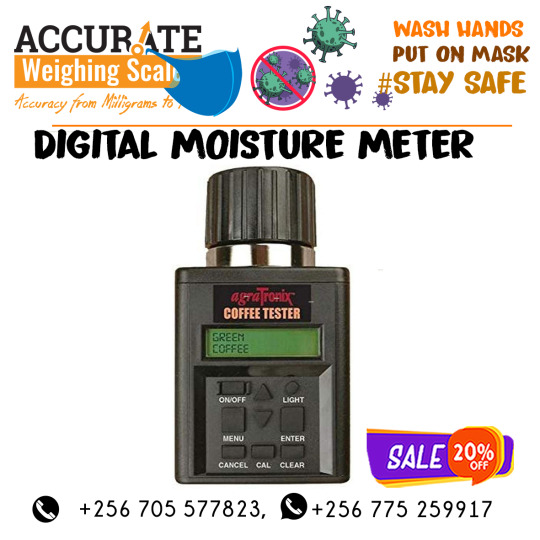
0 notes